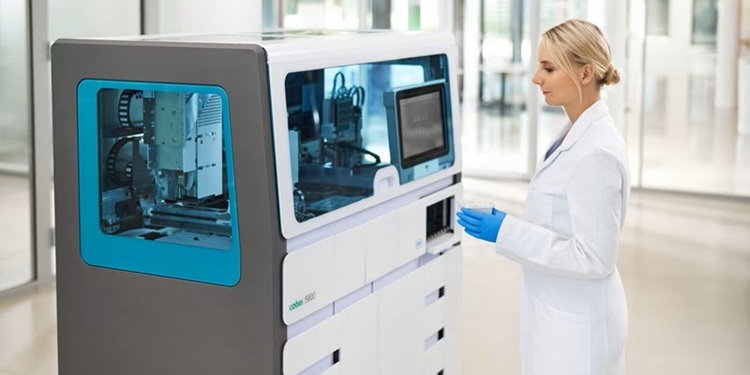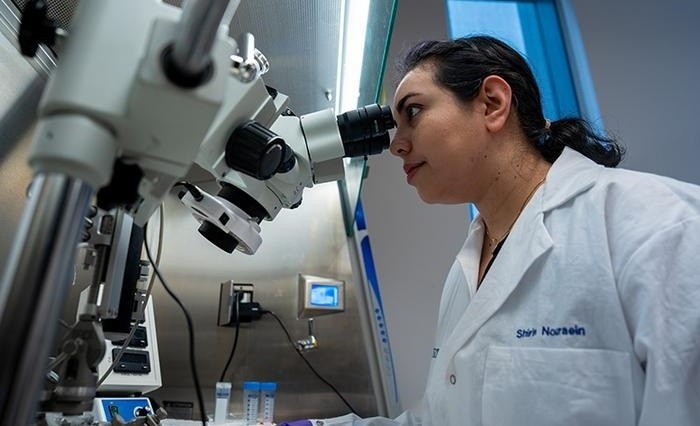Barth Syndrome Stem Cells Reveal Details of a Rare Heart Defect
|
By LabMedica International staff writers Posted on 27 May 2014 |

Image: The series of images shows how inserting modified RNA into diseased cells causes the cells to produce functioning versions of the TAZ protein (from left, green), which correctly localize in the mitochondria (red). When the images are merged to demonstrate this localization, green overlaps with red, giving the third image a yellow color around its edges (Photo courtesy of Harvard University).
Skin cells taken from Barth syndrome patients were used to generate stem cells that differentiated into defective heart tissue in culture.
Barth syndrome (type II 3-Methylglutaconic aciduria) is caused by mutation of the tafazzin gene. Tafazzin is responsible for remodeling of a phospholipid cardiolipin (CL), the signature lipid of the mitochondrial inner membrane. As a result, Barth syndrome patients exhibit defects in CL metabolism, including aberrant CL fatty acyl composition, accumulation of monolysocardiolipin (MLCL), and reduced total CL levels. About 120 cases of Barth syndrome, which is found exclusively in males, have been documented to date, but the syndrome is believed to be severely under-diagnosed and has been estimated to occur in one out of approximately 300,000 births.
Investigators at Harvard University (Cambridge, MA, USA) obtained skin cells from two Barth syndrome patients. The skin cells were induced to become stem cells carrying the patients’ TAZ mutations. The stem cells were cultured on chips lined with human extracellular matrix (ECM) proteins that mimicked their natural environment. Under these conditions the stem cells matured into a conglomerate of cardiomyocytes that mimicked heart tissue. Due to the presence of the TAZ mutations the heart tissue demonstrated very weak contractions, similar to a diseased human heart.
The investigators used this novel model system to define metabolic, structural, and functional abnormalities associated with TAZ mutation. They found that excess levels of reactive oxygen species (ROS) mechanistically linked TAZ mutation to impaired cardiomyocyte function. In addition, they used a gene therapy technique to provide the normal TAZ protein to the diseased tissue. Results published in the May 11, 2014, online edition of the journal Nature Medicine showed that inducing TAZ mutation in normal cardiomyocytes weakened contractions while addition of normal TAZ to the Barth syndrome cardiomyocytes corrected the contractile defect.
“The TAZ mutation makes Barth syndrome cells produce an excess amount of reactive oxygen species, or ROS—a normal byproduct of cellular metabolism released by mitochondria—which had not been recognized as an important part of this disease,” said senior author Dr. William Pu, associate professor of cardiology at Harvard University. “We showed that, at least in the laboratory, if you quench the excessive ROS production then you can restore contractile function. “Now, whether that can be achieved in an animal model or a patient is a different story, but if that could be done, it would suggest a new therapeutic angle.”
Related Links:
Harvard University
Barth syndrome (type II 3-Methylglutaconic aciduria) is caused by mutation of the tafazzin gene. Tafazzin is responsible for remodeling of a phospholipid cardiolipin (CL), the signature lipid of the mitochondrial inner membrane. As a result, Barth syndrome patients exhibit defects in CL metabolism, including aberrant CL fatty acyl composition, accumulation of monolysocardiolipin (MLCL), and reduced total CL levels. About 120 cases of Barth syndrome, which is found exclusively in males, have been documented to date, but the syndrome is believed to be severely under-diagnosed and has been estimated to occur in one out of approximately 300,000 births.
Investigators at Harvard University (Cambridge, MA, USA) obtained skin cells from two Barth syndrome patients. The skin cells were induced to become stem cells carrying the patients’ TAZ mutations. The stem cells were cultured on chips lined with human extracellular matrix (ECM) proteins that mimicked their natural environment. Under these conditions the stem cells matured into a conglomerate of cardiomyocytes that mimicked heart tissue. Due to the presence of the TAZ mutations the heart tissue demonstrated very weak contractions, similar to a diseased human heart.
The investigators used this novel model system to define metabolic, structural, and functional abnormalities associated with TAZ mutation. They found that excess levels of reactive oxygen species (ROS) mechanistically linked TAZ mutation to impaired cardiomyocyte function. In addition, they used a gene therapy technique to provide the normal TAZ protein to the diseased tissue. Results published in the May 11, 2014, online edition of the journal Nature Medicine showed that inducing TAZ mutation in normal cardiomyocytes weakened contractions while addition of normal TAZ to the Barth syndrome cardiomyocytes corrected the contractile defect.
“The TAZ mutation makes Barth syndrome cells produce an excess amount of reactive oxygen species, or ROS—a normal byproduct of cellular metabolism released by mitochondria—which had not been recognized as an important part of this disease,” said senior author Dr. William Pu, associate professor of cardiology at Harvard University. “We showed that, at least in the laboratory, if you quench the excessive ROS production then you can restore contractile function. “Now, whether that can be achieved in an animal model or a patient is a different story, but if that could be done, it would suggest a new therapeutic angle.”
Related Links:
Harvard University
Latest BioResearch News
- Genome Analysis Predicts Likelihood of Neurodisability in Oxygen-Deprived Newborns
- Gene Panel Predicts Disease Progession for Patients with B-cell Lymphoma
- New Method Simplifies Preparation of Tumor Genomic DNA Libraries
- New Tool Developed for Diagnosis of Chronic HBV Infection
- Panel of Genetic Loci Accurately Predicts Risk of Developing Gout
- Disrupted TGFB Signaling Linked to Increased Cancer-Related Bacteria
- Gene Fusion Protein Proposed as Prostate Cancer Biomarker
- NIV Test to Diagnose and Monitor Vascular Complications in Diabetes
- Semen Exosome MicroRNA Proves Biomarker for Prostate Cancer
- Genetic Loci Link Plasma Lipid Levels to CVD Risk
- Newly Identified Gene Network Aids in Early Diagnosis of Autism Spectrum Disorder
- Link Confirmed between Living in Poverty and Developing Diseases
- Genomic Study Identifies Kidney Disease Loci in Type I Diabetes Patients
- Liquid Biopsy More Effective for Analyzing Tumor Drug Resistance Mutations
- New Liquid Biopsy Assay Reveals Host-Pathogen Interactions
- Method Developed for Enriching Trophoblast Population in Samples
Channels
Clinical Chemistry
view channel
Chemical Imaging Probe Could Track and Treat Prostate Cancer
Prostate cancer remains a leading cause of illness and death among men, with many patients eventually developing resistance to standard hormone-blocking therapies. These drugs often lose effectiveness... Read more
Mismatch Between Two Common Kidney Function Tests Indicates Serious Health Problems
Creatinine has long been the standard for measuring kidney filtration, while cystatin C — a protein produced by all human cells — has been recommended as a complementary marker because it is influenced... Read moreMolecular Diagnostics
view channel
Genetic Marker to Help Children with T-Cell Leukemia Avoid Unnecessary Chemotherapy
About 400 children in the UK are diagnosed with acute lymphoblastic leukemia (ALL) each year, with roughly 15% presenting with a more aggressive T-ALL subtype. While the standard approach is a four-week... Read more
Four-Gene Blood Test Rules Out Bacterial Lung Infection
Lower respiratory tract infections (LRTIs) are among the most common reasons for antibiotic prescriptions, yet distinguishing bacterial infections from viral ones remains notoriously difficult.... Read more
New PCR Test Improves Diagnostic Accuracy of Bacterial Vaginosis and Candida Vaginitis
Bacterial vaginosis (BV) impacts approximately 25% of women of reproductive age, while up to 75% of women experience candida vaginitis (CV) at least once in their lifetime. Vaginal symptoms are one of... Read moreHematology
view channel
Platelet Activity Blood Test in Middle Age Could Identify Early Alzheimer’s Risk
Early detection of Alzheimer’s disease remains one of the biggest unmet needs in neurology, particularly because the biological changes underlying the disorder begin decades before memory symptoms appear.... Read more
Microvesicles Measurement Could Detect Vascular Injury in Sickle Cell Disease Patients
Assessing disease severity in sickle cell disease (SCD) remains challenging, especially when trying to predict hemolysis, vascular injury, and risk of complications such as vaso-occlusive crises.... Read more
ADLM’s New Coagulation Testing Guidance to Improve Care for Patients on Blood Thinners
Direct oral anticoagulants (DOACs) are one of the most common types of blood thinners. Patients take them to prevent a host of complications that could arise from blood clotting, including stroke, deep... Read moreImmunology
view channel
New Test Distinguishes Vaccine-Induced False Positives from Active HIV Infection
Since HIV was identified in 1983, more than 91 million people have contracted the virus, and over 44 million have died from related causes. Today, nearly 40 million individuals worldwide live with HIV-1,... Read more
Gene Signature Test Predicts Response to Key Breast Cancer Treatment
DK4/6 inhibitors paired with hormone therapy have become a cornerstone treatment for advanced HR+/HER2– breast cancer, slowing tumor growth by blocking key proteins that drive cell division.... Read more
Chip Captures Cancer Cells from Blood to Help Select Right Breast Cancer Treatment
Ductal carcinoma in situ (DCIS) accounts for about a quarter of all breast cancer cases and generally carries a good prognosis. This non-invasive form of the disease may or may not become life-threatening.... Read moreMicrobiology
view channel
Rapid Diagnostic Test Matches Gold Standard for Sepsis Detection
Sepsis kills 11 million people worldwide every year and generates massive healthcare costs. In the USA and Europe alone, sepsis accounts for USD 100 billion in annual hospitalization expenses.... Read moreRapid POC Tuberculosis Test Provides Results Within 15 Minutes
Tuberculosis remains one of the world’s deadliest infectious diseases, and reducing new cases depends on identifying individuals with latent infection before it progresses. Current diagnostic tools often... Read more
Rapid Assay Identifies Bloodstream Infection Pathogens Directly from Patient Samples
Bloodstream infections in sepsis progress quickly and demand rapid, precise diagnosis. Current blood-culture methods often take one to five days to identify the pathogen, leaving clinicians to treat blindly... Read morePathology
view channelAI Tool Outperforms Doctors in Spotting Blood Cell Abnormalities
Diagnosing blood disorders depends on recognizing subtle abnormalities in cell size, shape, and structure, yet this process is slow, subjective, and requires years of expert training. Even specialists... Read more
AI Tool Rapidly Analyzes Complex Cancer Images for Personalized Treatment
Complex digital biopsy images that typically take an expert pathologist up to 20 minutes to assess can now be analyzed in about one minute using a new artificial intelligence (AI) tool. The technology... Read moreTechnology
view channel
Artificial Intelligence Model Could Accelerate Rare Disease Diagnosis
Identifying which genetic variants actually cause disease remains one of the biggest challenges in genomic medicine. Each person carries tens of thousands of DNA changes, yet only a few meaningfully alter... Read more
AI Saliva Sensor Enables Early Detection of Head and Neck Cancer
Early detection of head and neck cancer remains difficult because the disease produces few or no symptoms in its earliest stages, and lesions often lie deep within the head or neck, where biopsy or endoscopy... Read moreIndustry
view channel
Abbott Acquires Cancer-Screening Company Exact Sciences
Abbott (Abbott Park, IL, USA) has entered into a definitive agreement to acquire Exact Sciences (Madison, WI, USA), enabling it to enter and lead in fast-growing cancer diagnostics segments.... Read more























